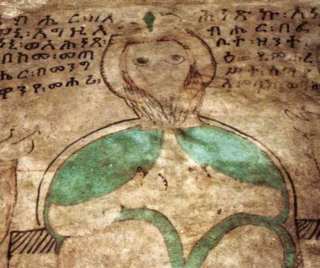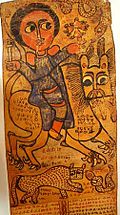
Gudit is the Classical Ethiopic name for a personage also known as Yodit in Tigrinya, and Amharic, but also Isato in Amharic, and Ga'wa in Ţilţal. The person behind these various alternative names is portrayed as a powerful female ruler, probably identical to Māsobā Wārq, the daughter of the last Aksumite king, Dil Na'ad, mentioned in an early Arabic source. She is said to have been responsible for laying waste the Kingdom of Aksum and its countryside, and the destruction of its churches and monuments in the 10th century AD. If she is the same as the Tirda' Gābāz in other Ethiopian sources, she is also said to have attempted to exterminate the members of the ruling dynasty. The deeds attributed to her are recorded in oral tradition and in a variety of historical narratives.

Abune Tekle Haymanot was an Ethiopian saint and monk mostly venerated as a hermit. He was the Abuna of Ethiopia who founded a major monastery in his native province of Shewa. He is significant for being the only Ethiopian saint popular both amongst Ethiopians and outside that country. Tekle Haymanot "is the only Ethiopian saint celebrated officially in foreign churches such as Rome and Egypt." His feast day is 30 August, and the 24th day of every month in the Ethiopian calendar is dedicated to Tekle Haymanot.

The Zagwe dynasty was a medieval Agaw monarchy that ruled the northern parts of Ethiopia and Eritrea. The Agaw are a Cushitic ethnic group native to the northern highlands of Ethiopia and neighboring Eritrea. It ruled large parts of the territory from approximately 1137 to 1270 AD, when the last Zagwe King Za-Ilmaknun was killed in battle by the forces of the Amhara King Yekuno Amlak. The Zagwe are most famous for their king Gebre Meskel Lalibela, who is credited with having ordered the construction of the rock-hewn monolithic churches of Lalibela.

Yekuno Amlak ; throne name Tesfa Iyasus was Emperor of Ethiopia, from 1270 to 1285, and the founder of the Solomonic dynasty, which lasted until 1974. He was a ruler from Bete Amhara who became the Emperor of Ethiopia following the defeat of the last Zagwe king.
Newaya Krestos was Emperor of Ethiopia from 1344 to 1372, and a member of the Solomonic dynasty. He was the eldest son of Amda Seyon I.
Zara Yaqob was Emperor of Ethiopia, and a member of the Solomonic dynasty who ruled under the regnal name Qostantinos I. He is known for the Geʽez literature that flourished during his reign, the handling of both internal Christian affairs and external wars with Muslims, along with the founding of Debre Birhan as his capital. He reigned for 34 years and 2 months.

Yagbe'u Seyon, throne name Salomon, was Emperor of Ethiopia from 18 June 1285 to 1294, and a member of the Solomonic dynasty. He succeeded his father Yekuno Amlak.

Lake Hayq is a freshwater lake of Ethiopia. It is located north of Dessie, in the Debub Wollo Zone of the Amhara Region. The town of Hayq is to the west of the lake.

Iyasus Mo'a was an Ethiopian saint of the Ethiopian Orthodox Tewahedo Church; his feast day is 5 December. In life he was an Ethiopian monk and abbot of Istifanos Monastery in Lake Hayq of Amba Sel.

Istifanos Monastery is a monastery in Ethiopia, located in Lake Hayq. The church structure was built around the 9th century by the Aksumite king Dil Na'od. In the 13th century, the church was converted into a monastery, in large part due to the work of Saint Iyasus Mo'a and later Emperor Yekuno Amlak.

Ewostatewos was an Ethiopian religious leader of the Orthodox Tewahedo during the early period of the Solomonic dynasty of Ethiopian Empire. He was a forceful advocate for the observation of the Sabbath in Christianity. His followers, known as the House of Ewostatewos, have been a historic force in Tewahedo Orthodoxy.
Degna Djan was an Emperor of the Kingdom of Aksum. Paul B. Henze states that his throne name was "'Anbasa Wedem", which tradition states was his oldest son's name. His younger son was Dil Na'od.

Abuna Aregawi was a sixth-century Syrian monk and canonized by the Ethiopian Orthodox Tewahedo Church, as well as by the Ethiopian Catholic Church, as well as the Eritrean Orthodox Church. He is one of the Nine Saints, who came from the Roman Empire to Ethiopia, and are credited for founding many monasteries and churches and was the main force behind installing monasticism in Ethiopia.

Christianity in Ethiopia is the country's largest religion with members making up 68% of the population.
Abba 'Ěnbāqom born Ab'ul-Fath was a Yemeni polyglot, religious leader of the Ethiopian Orthodox Tewahedo Church, translator, and author of the Anqaṣa Amin. As Abbot at the leading monastery of Debre Libanos he became the Echage, the second highest ecclesiastical office, as well as head of all Ethiopian monasteries, and was often regarded as the most influential person in the Ethiopian Church.

Abba Garima Monastery is an Ethiopian Orthodox church, located around five kilometres east of Adwa, in the Mehakelegnaw Zone of the northern Tigray Region in Ethiopia. It was established in the sixth century by one of the Nine Saints, Abba Garima, and built by King Gabra Masqal. The monastery became known for its early manuscript copy of the gospels and its treasury.

The Garima Gospels are three ancient Ethiopic manuscripts containing all four canonical Gospel Books, as well as some supplementary material like lists of Gospel chapters. Garima 2, the earliest, is believed to be the earliest surviving complete illuminated Christian manuscript. Monastic tradition holds that the first two were composed close to the year 500, a date supported by recent radiocarbon analysis; samples from Garima 2 proposed a date of c. 390–570, while counterpart dating of samples from Garima 1 proposed a date of c. 530–660. The third manuscript is thought to date to a later period. The artwork in the manuscripts of the Garima Gospels also demonstrates their affinity to Christian artwork in late antique Coptic Egypt, Nubia, and Himyar (Yemen).
Salama II was Abuna, or head of the Ethiopian Orthodox Church from 1348 to 1388. During his tenure a number of translations into the Ge'ez language appeared, which has resulted with him being remembered as "Abba Salama, the Translator."

Taddesse Tamrat was an Ethiopian historian and scholar of Ethiopian studies. He is best known as the author of Church and State in Ethiopia 1270–1520, a book which has dominated the field of Ethiopian studies.
Abba Aftse or ‘Afsé was one of the Nine Saints of Ethiopia.















